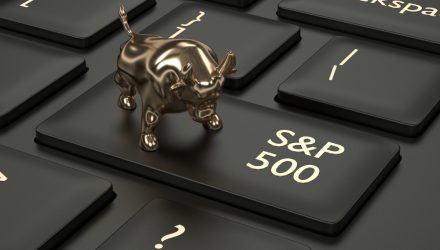When it comes to stocks and bonds, global investment firm Goldman Sachs gives the former a 90% chance that it will outperform its fixed income counterpart over the next decade. Given those odds, it’s time to push all-in on stocks.
Per a CNBC report, the firm “believes that the S&P 500 will return an average of 6% over the next ten years, including dividends, with the high and low forecasts coming in at 11% and 2%, respectively.”
“Our analysis implies an investor buying both assets today has a 90% probability of generating a superior return from stocks compared with holding a 10-year US Treasury note through its maturity in 2030,” the firm said.
One way to get market exposure to stocks is via a basket of stocks a la exchange-traded funds (ETFs). As markets flux, different sectors will tend to outperform others thereby requiring money managers to increase exposure to certain sectors or specific equities and then limiting exposure to others via active management.
Equal Weighted Exposure
When it comes to passive management, exposure via market capitalization size could expose investors to certain concentration risks, but there’s an alternative—an equal cap weighting strategy via funds like the Goldman Sachs Equal Weight U.S. Large Cap Equity ETF (GSEW). GSEW seeks to provide investment results that closely correspond, before fees and expenses, to the performance of the Solactive US Large Cap Equal Weight Index (GTR).
The index consists of equity securities of large-capitalization U.S. issuers. The index is an equal-weight version of the Solactive US Large Cap Index, a market capitalization-weighted index that includes equity securities of approximately 500 of the largest U.S. companies.
GSEW offers investors:
- Market cap bias avoidance: By tracking an index that equally weights the largest U.S. equities and rebalancing monthly, GSEW seeks to avoid concentration in the largest names. This approach may allow the fund to participate in a broad range of market cycles and potentially reduce exposure to isolated market incidents.
- Systematic rebalancing strategy: To maintain a target equal weight across approximately 500 of the largest U.S. equities, GSEW seeks to track an index that employs a disciplined and systematic monthly rebalancing process. Monthly index rebalancing enables the fund to adjust to market movements and better maintain its equal weighting.
- Cost-effectiveness: Priced to investors at 9 basis points, GSEW is among the most competitively priced Exchange-Traded Funds (ETFs) on the market. By comparison, the industry average for smart beta ETFs is 34 basis points (bps).
While market cap-weighted strategies certainly have their merits, particularly when heavy concentrations in the largest companies are outperforming the broad market, there are certain drawbacks. It can reduce exposure to smaller companies that are also outperforming but don’t get the necessary exposure.
For more market trends, visit ETF Trends.









